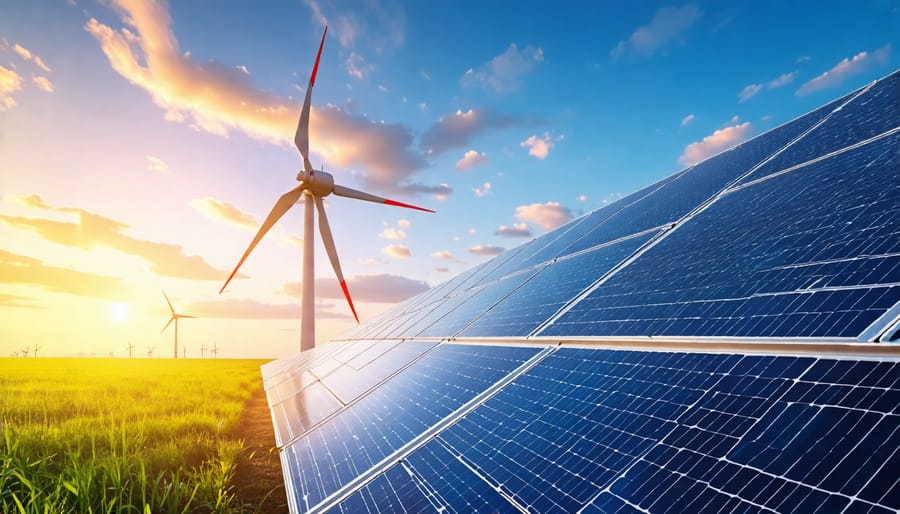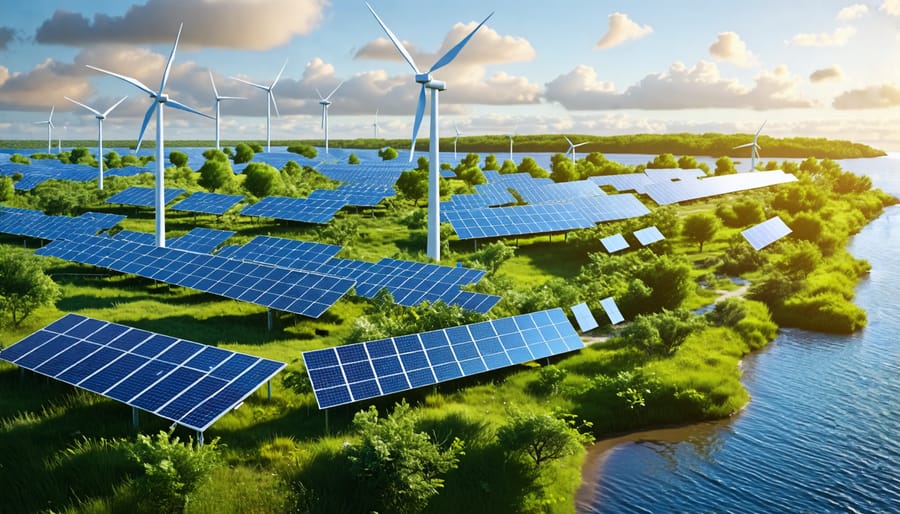Invest in resilient infrastructure to enhance energy systems’ durability against climate events. Retrofit existing facilities with weather-resistant materials and elevate power plants in flood-prone areas to reduce outage risks. Diversify energy sources by integrating renewables like wind and solar, which reduce dependence on fossil fuels and bolster energy stability. Collaborate with local governments to implement microgrid systems that enhance community energy autonomy and provide critical backup during natural disasters. Leverage technology by utilizing data analytics and IoT for real-time monitoring and predictive maintenance of energy assets to prevent disruptions and optimize operation efficiency. Each of these strategies not only aids in climate resilience but also advances sustainable energy goals, pivotal for an adaptive, thriving future.
Understanding Climate Change Adaptation
Climate change adaptation involves making adjustments in environmental, social, and economic systems to better cope with the effects of climate change. This strategy is crucial to ensure that communities, economies, and ecosystems can thrive despite climatic shifts. As extreme weather events become more frequent and sea levels rise, adaptation helps safeguard natural habitats, infrastructure, and food security. For example, coastal communities are pioneering adaptive measures by constructing sea walls and restoring mangrove forests, which serve as natural buffers against storm surges and erosion.
In the energy sector, climate change adaptation has a significant role in maintaining economic resilience. For instance, solar and wind energy companies are optimizing the design of their infrastructure to withstand extreme weather events, ensuring consistent and reliable energy supply. This proactive approach not only prevents potential disruptions in energy production but also reduces long-term costs associated with infrastructure damage and repairs.
Moreover, adaptation strategies foster innovation and economic opportunities by encouraging investments in new technologies and sustainable practices. By integrating climate change adaptation into planning and development, industries can create sustainable growth pathways that align with environmental goals, ultimately contributing to a more resilient and verdant future. With ongoing adaptation efforts, we are well-equipped to turn climate challenges into avenues for progress, ensuring a sustainable energy landscape for generations to come.
Energy Sector’s Role in Climate Adaptation
Renewable Energy Advancements
Recent advancements in renewable energy technology are pivotal in adapting to climate change, showcasing promising developments across various sectors. A shining example is the remarkable progress in innovations in wind energy. These advancements have led to the creation of more efficient turbines, capable of generating power even at lower wind speeds, thereby maximizing energy production and reducing reliance on fossil fuels. Additionally, solar technology is not far behind, with recent breakthroughs in photovoltaic cells improving energy conversion rates significantly. This not only accelerates the transition to cleaner energy but also supports decentralized power generation, allowing communities to become more resilient and less dependent on grid connections vulnerable to climate impacts.
Moreover, innovations in energy storage solutions, such as enhanced battery technologies and pumped hydro storage systems, are crucial. By ensuring consistent energy supply even when renewable sources fluctuate, these advancements solidify renewable energy as a cornerstone of climate adaptation strategies. These technologies empower both individuals and entire regions to better withstand environmental changes, igniting hope for a sustainable future.

Grid Resilience Innovations
As climate-induced disruptions become more frequent, innovative strategies are essential to bolster the resilience of our energy grids. One cutting-edge solution is the integration of microgrids. These smaller, localized grids can operate independently from the traditional central grid, allowing communities to maintain power even during widespread outages. The town of Borrego Springs in California serves as an inspiring case study, where a microgrid system effectively restored power within hours during a massive storm outage in 2013.
Furthermore, grid-scale battery storage systems are gaining traction. These systems store excess energy generated during periods of low demand, such as solar power on a sunny day, and release it when demand surges. In places like South Australia, battery installations have already demonstrated their ability to stabilize the grid and minimize blackouts during extreme weather events.
Advancements in artificial intelligence (AI) and machine learning are also revolutionizing grid management. By analyzing vast amounts of data, these technologies can predict potential grid failures and automate responses to mitigate impact. This proactive management system was crucial during the 2020 wildfires in California, where AI helped utilities better allocate resources and prevent outages.
These innovations highlight the potential to transform our energy systems into robust and adaptive networks, ensuring reliable and sustainable power in the face of climate challenges.

Real-Life Examples of Adaptation Strategies
Case Study: Offshore Wind in Denmark
Denmark has long been a pioneer in harnessing wind energy, and its successful implementation of offshore wind projects exemplifies a remarkable approach to climate adaptation. As the impacts of climate change become more pronounced, Denmark has effectively demonstrated the viability of transitioning to sustainable energy sources, setting a global benchmark.
Beginning in the early 2000s, Denmark undertook ambitious projects to develop offshore wind farms, tailored to not only meet energy demands but also to withstand changing climatic conditions. These wind farms have proven to be a robust solution, reducing reliance on fossil fuels and significantly curbing carbon emissions.
The strategic location of Denmark’s offshore wind farms allows them to harness powerful wind currents, producing a substantial share of the nation’s electricity. As of today, these installations supply over 40% of Denmark’s electricity, showcasing a scalable model for other nations aspiring to transition to renewable energy sources. This success is underpinned by collaborative efforts between government entities, energy companies, and local communities, which have facilitated the integration of renewable energy into the national grid.
Beyond their contribution to energy production, Denmark’s offshore wind projects have taken into consideration the protection of marine biodiversity. Innovative designs and practices have ensured minimal disruption to marine life, promoting ecological balance and sustainability. By prioritizing both environmental preservation and energy efficiency, these projects stand as a steadfast example of how countries can adapt to and mitigate the effects of climate change while paving the way for a cleaner, more sustainable future.

Case Study: Solar Microgrids in Africa
Solar microgrids are revolutionizing energy access across Africa, providing a beacon of hope in the face of climate change challenges. These decentralized power systems harness solar energy, offering communities a reliable and sustainable electricity source, crucial in regions where traditional power infrastructure is lacking or unreliable. By employing solar microgrids, African villages can leapfrog fossil fuels, reducing greenhouse gas emissions and mitigating climate change impacts.
In regions like East Africa, where traditional energy sources are vulnerable to climate-induced disruptions such as droughts and floods, solar microgrids present a resilient alternative. For instance, in rural Tanzania, a community operated solar microgrid powers homes, schools, and medical facilities, significantly improving quality of life while fostering economic development. By incorporating local knowledge and resources, these systems are tailored to community needs, ensuring their sustainability and effectiveness.
Moreover, this technology supports climate adaptation by enhancing water access through solar-powered pumps and irrigation systems. This is particularly vital in drought-prone areas, where consistent water supply can transform agriculture, bolster food security, and strengthen community resilience. Solar microgrids also encourage educational advancements by providing electricity to schools, enabling evening classes and extending learning opportunities.
The success of solar microgrids in Africa demonstrates their potential as a scalable solution to both energy poverty and climate vulnerability. By investing in these renewable energy systems, African nations are setting a precedent for sustainable development, showcasing an innovative path forward in the global effort to adapt to a changing climate. Through collaborative efforts and continued innovation, solar microgrids hold the promise of a brighter, more sustainable future for communities across the continent.
Policy and Community Engagement
Government Initiatives
Governments worldwide are spearheading climate adaptation efforts through a series of innovative policies designed to reduce vulnerability and enhance resilience. One compelling example is the European Union’s Adaptation Strategy. Launched in 2021, it aims to transition the EU to a climate-resilient society by promoting investments in green infrastructure and encouraging sustainable urban planning. This aligns closely with the global drive to modernize energy systems, echoing initiatives like Morocco’s Noor Solar Project. This ambitious endeavor not only prioritizes renewable energy but also includes measures to protect local ecosystems from climate impacts.
In Australia, the National Climate Resilience and Adaptation Strategy provides a blueprint for community-based initiatives, emphasizing local solutions to climate threats, such as the creation of coastal defense systems and water management innovations. Meanwhile, the United States is advancing policy through the Adaptation Fund, channeling resources into projects that fortify critical infrastructure against extreme weather events. Each of these governmental moves, inspired by a mix of top-down policy-making and grassroots innovation, is crucial in building a sustainable future in the face of changing climatic conditions.
Community-Based Approaches
Local community involvement is crucial for the success of adaptation strategies to climate change. By engaging residents, these approaches harness local knowledge and foster resilience. Communities actively participating in adaptation efforts can better address specific challenges and needs, making the strategies more tailored and effective. This participatory process not only empowers individuals but also encourages innovation and sustainable practices. As local populations are directly impacted by climate change, their involvement ensures that adaptation measures are practical and implementable. For further insights into boosting community engagement in renewable energy, explore approaches that prioritize collaboration and shared goals, driving a more sustainable future.
Conclusion
In conclusion, addressing climate change through adaptation strategies is not just necessary; it is an opportunity to foster resilience and innovation. As we’ve explored through real-life examples and expert insights, the energy industry holds a significant role in this transformation. By embracing renewable energy sources, investing in technological advancements, and advocating for supportive policies, we can all contribute to a sustainable future. The path towards adaptation is filled with challenges, but with determination and collaboration, these hurdles can be overcome. Whether you are an educator, policy-maker, or an individual committed to environmental stewardship, you can play a part in this critical journey. Consider how you might implement these strategies in your personal or professional context, and encourage dialogue and action within your community. Together, we can adapt not only to survive but to thrive in the face of climate change.





